Related Research Articles

Hay is grass, legumes, or other herbaceous plants that have been cut and dried to be stored for use as animal fodder, either for large grazing animals raised as livestock, such as cattle, horses, goats, and sheep, or for smaller domesticated animals such as rabbits and guinea pigs. Pigs can eat hay, but do not digest it as efficiently as herbivores do.
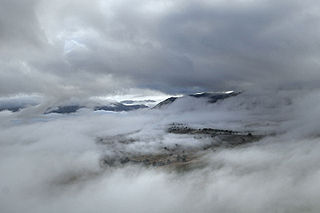
An aerosol is a suspension of fine solid particles or liquid droplets in air or another gas. Aerosols can be natural or anthropogenic. The term aerosol commonly refers to the particulate/air mixture, as opposed to the particulate matter alone. Examples of natural aerosols are fog or mist, dust, forest exudates, and geyser steam. Examples of anthropogenic aerosols include particulate air pollutants, mist from the discharge at hydroelectric dams, irrigation mist, perfume from atomizers, smoke, dust, steam from a kettle, sprayed pesticides, and medical treatments for respiratory illnesses. When a person inhales the contents of a vape pen or e-cigarette, they are inhaling an anthropogenic aerosol.
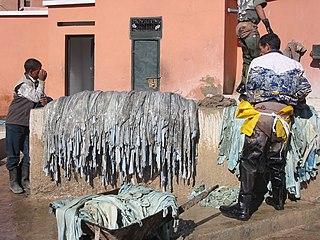
Tanning is the process of treating skins and hides of animals to produce leather. A tannery is the place where the skins are processed.

Spray drying is a method of forming a dry powder from a liquid or slurry by rapidly drying with a hot gas. This is the preferred method of drying of many thermally-sensitive materials such as foods and pharmaceuticals, or materials which may require extremely consistent, fine particle size. Air is the heated drying medium; however, if the liquid is a flammable solvent such as ethanol or the product is oxygen-sensitive then nitrogen is used.

Silage is a type of fodder made from green foliage crops which have been preserved by fermentation to the point of acidification. It can be fed to cattle, sheep, and other such ruminants. The fermentation and storage process is called ensilage, ensiling, or silaging. Silage is usually made from grass crops, including maize, sorghum, or other cereals, using the entire green plant.

Idli or idly is a type of savoury rice cake, originating from South India, popular as a breakfast food in Southern India and in Sri Lanka. The cakes are made by steaming a batter consisting of fermented black lentils (de-husked) and rice. The fermentation process breaks down the starches so that they are more readily metabolised by the body.
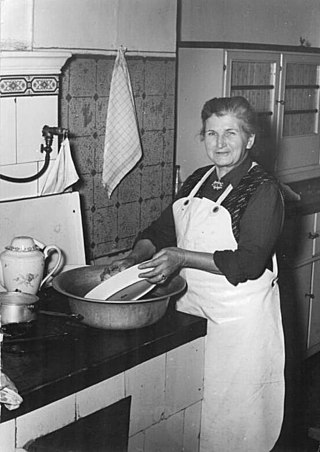
Dishwashing, washing the dishes, doing the dishes, or washing up in Great Britain, is the process of cleaning cooking utensils, dishes, cutlery and other items to prevent foodborne illness. This is either achieved by hand in a sink using dishwashing detergent or by using a dishwasher and may take place in a kitchen, utility room, scullery or elsewhere.

Parboiled rice is rice that has been partially boiled in the husk. The three basic steps of parboiling are soaking, steaming and drying. These steps make the rice easier to process by hand, while also boosting its nutritional profile, changing its texture, and making it more resistant to weevils. The treatment is practiced in many parts of the world.

An electrostatic precipitator (ESP) is a filterless device that removes fine particles, such as dust and smoke, from a flowing gas using the force of an induced electrostatic charge minimally impeding the flow of gases through the unit.
Choke is a condition in horses in which the esophagus is blocked, usually by food material. Although the horse is still able to breathe, it is unable to swallow, and may become severely dehydrated. A secondary condition, aspiration pneumonia, may also develop if food material and saliva accumulate in the pharynx, spilling into the trachea and into the lungs. Choke is one of the "top 10" emergencies received by equine veterinarians.
Recurrent airway obstruction, also known as broken wind, heaves, wind-broke horse, or sometimes by the term usually reserved for humans, chronic obstructive pulmonary disease or disorder (COPD) – it is a respiratory disease or chronic condition of horses involving an allergic bronchitis characterised by wheezing, coughing and laboured breathing.

Spontaneous combustion or spontaneous ignition is a type of combustion which occurs by self-heating, followed by thermal runaway and finally, autoignition.

Equine nutrition is the feeding of horses, ponies, mules, donkeys, and other equines. Correct and balanced nutrition is a critical component of proper horse care.

Beet pulp is a byproduct from the processing of sugar beet which is used as fodder for horses and other livestock. Beet pulp is the fibrous material left over after the sugar is extracted from sugar beets. It is supplied either as dried flakes or as compressed pellets, but when fed to horses it should always be soaked in water first.

Equine metabolic syndrome (EMS) is an endocrinopathy affecting horses and ponies. It is of primary concern due to its link to obesity, insulin dysregulation, and subsequent laminitis. There are some similarities in clinical signs between EMS and pituitary pars intermedia dysfunction, also known as PPID or Cushing's disease, and some equines may develop both, but they are not the same condition, having different causes and different treatment.

Vapor steam cleaners or steam vapor systems are cleaning appliances or devices that use steam to quickly dry, clean, and sanitize surfaces. The steam is produced in a boiler that heats tap water to high temperatures (240–310F/115–155°C) to produce low-pressure, low moisture water vapor.
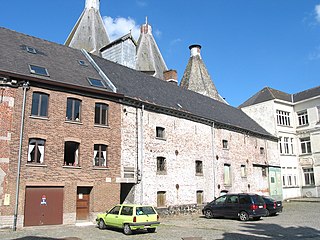
A malt house, malt barn, or maltings, is a building where cereal grain is converted into malt by soaking it in water, allowing it to sprout and then drying it to stop further growth. The malt is used in brewing beer, whisky and in certain foods. The traditional malt house was largely phased out during the twentieth century in favour of more mechanised production. Many malt houses have been converted to other uses, such as Snape Maltings, England, which is now a concert hall.
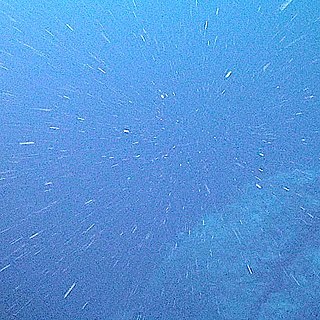
In the deep ocean, marine snow is a continuous shower of mostly organic detritus falling from the upper layers of the water column. It is a significant means of exporting energy from the light-rich photic zone to the aphotic zone below, which is referred to as the biological pump. Export production is the amount of organic matter produced in the ocean by primary production that is not recycled (remineralised) before it sinks into the aphotic zone. Because of the role of export production in the ocean's biological pump, it is typically measured in units of carbon. The term was coined by explorer William Beebe as observed from his bathysphere. As the origin of marine snow lies in activities within the productive photic zone, the prevalence of marine snow changes with seasonal fluctuations in photosynthetic activity and ocean currents. Marine snow can be an important food source for organisms living in the aphotic zone, particularly for organisms that live very deep in the water column.

Bedding, in ethology and animal husbandry, is material, usually organic, used by animals to support their bodies when resting or otherwise stationary. It reduces pressure on skin, heat loss, and contamination by waste produced by an animal or those it shares living space with.

Huangjiu is a type of Chinese alcoholic beverage most popular in the Jiangnan area. Huangjiu is brewed by mixing boiled grains including rice, glutinous rice or millet with qū as starter culture, followed by saccharification and fermentation at around 13–18 °C (55–64 °F) for fortnights. Its alcohol content is typically 8% to 20%.
References
- 1 2 Moore-Colyer, M.J.S.; Payne, V. (2012). "Palatability and ingestion behaviour of 6 polo ponies offered a choice of dry, soaked and steamed hay for 1 hour on three separate occasions". Advances in Animal Biosciences. Healthy Food from Healthy Animals. 3 (1): 127.
- ↑ Hessel, Engel F.; Garlipp, Felix; Van den Weghe, Herman F.A. (September 2009). "Generation of Airborne Particles from Horse Feeds Depending on Type and Processing". Journal of Equine Veterinary Science. 29 (9): 665–674. doi:10.1016/j.jevs.2009.07.013.
- ↑ Blundell, E. L.; Adjei, L. J.; Brigden, C. V. (2012). "The effect of steaming and soaking treatments on respirable dust content of hay and the potential environmental polluting impact of the waste water produced". Forages and grazing in horse nutrition. pp. 125–128. doi:10.3920/978-90-8686-755-4_13. ISBN 978-90-8686-755-4.
- ↑ Blackman, M.; Moore-Colyer, M. J. S. (2 September 2010). "Hay for horses: the effects of three different wetting treatments on dust and nutrient content". Animal Science. 66 (3): 745–750. doi:10.1017/S1357729800009334.
- ↑ Moore-Colyer, Meriel Jean Scott; Lumbis, Kimberly; Longland, Annette; Harris, Patricia (26 November 2014). "The Effect of Five Different Wetting Treatments on the Nutrient Content and Microbial Concentration in Hay for Horses". PLOS ONE. 9 (11): e114079. Bibcode:2014PLoSO...9k4079M. doi: 10.1371/journal.pone.0114079 . PMC 4245254 . PMID 25426729.
- 1 2 Warr, E. M.; Petch, J. L. (June 1993). "Effects of soaking hay on its nutritional quality". Equine Veterinary Education. 5 (3): 169–171. doi:10.1111/j.2042-3292.1993.tb01031.x.
- ↑ Moore-Colyer, Meriel J.S.; Taylor, Jessica L.E.; James, Rebecca (April 2016). "The Effect of Steaming and Soaking on the Respirable Particle, Bacteria, Mould, and Nutrient Content in Hay for Horses". Journal of Equine Veterinary Science. 39: 62–68. doi:10.1016/j.jevs.2015.09.006.
- ↑ Moore-Colyer, M. J. S.; Fillery, B. G. (2012). "The effect of three different treatments on the respirable particle content, total viable count and mould concentrations in hay for horses". Forages and grazing in horse nutrition. pp. 101–106. doi:10.3920/978-90-8686-755-4_9. ISBN 978-90-8686-755-4.
- ↑ Brown, E.; Tracey, S; Gowers, I. (April 2013). An investigation to determine the palatability of steamed hay, dry hay and haylage. Proceedings of British Society of Animal Science Conference. Nottingham. p. 104.
{{cite conference}}: CS1 maint: date and year (link) - ↑ Dauvillier and Westergren 2016[ full citation needed ]